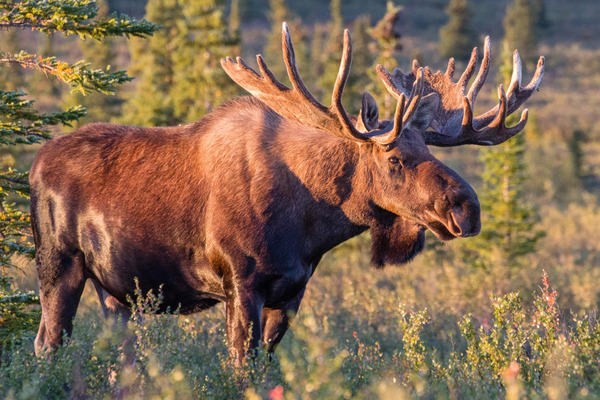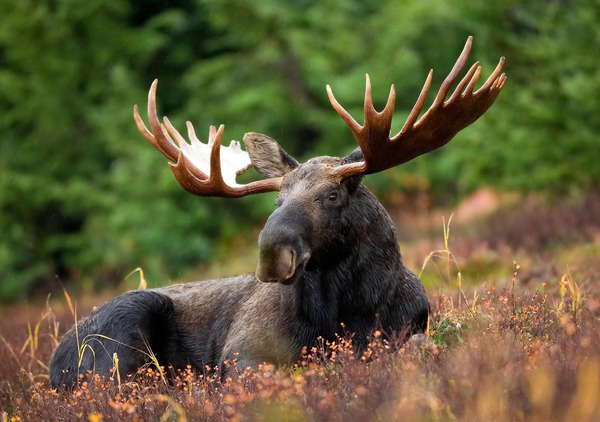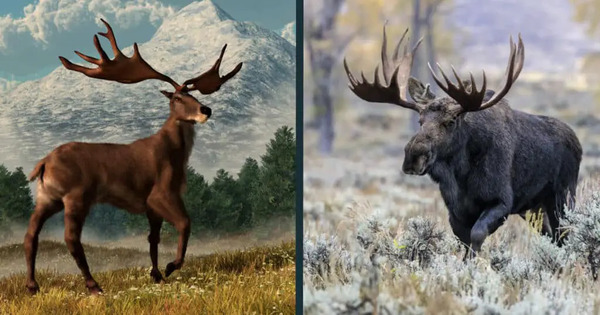Moose are one of the most fascinating and impressive animals found in North America and parts of Europe and Asia. Known for their enormous size, distinctive antlers, and unique adaptations, these gentle giants have captured the imagination of many. In this article, we'll explore everything you need to know about moose, including their habitat, diet, behavior, and conservation status.

Moose (Alces alces) are the largest members of the deer family, Cervidae. Adult moose can weigh anywhere from 800 to 1,600 pounds (360 to 725 kilograms) and stand over 6 feet (1.8 meters) tall at the shoulder. They have long legs, a hump on their backs, and a large, broad nose. One of their most striking features is the impressive set of antlers that males grow each year.
Moose are primarily found in the northern regions of North America, including Canada and Alaska, as well as parts of northern Europe and Asia. They prefer habitats near water sources, such as lakes, rivers, and wetlands, where they can find plenty of food. These areas provide abundant vegetation, which is essential for their diet.
Forests: Moose thrive in coniferous and mixed forests, where they can find shelter and food.
Wetlands: Swamps, marshes, and ponds are prime feeding grounds for moose, as they enjoy aquatic plants.
Rural Areas: Moose are often seen wandering in rural communities, especially in areas close to forests and water.
Moose are herbivores, which means they primarily eat plants. Their diet varies by season and availability, but they enjoy a wide range of vegetation, including:
Leaves and Twigs: In spring and summer, moose feed on tender leaves and twigs from trees and shrubs.
Aquatic Plants: During warmer months, they dive underwater to eat aquatic plants like water lilies and pondweeds.
Bark and Foliage: In winter, when food is scarce, they rely on the bark of trees, especially birch and aspen.
Moose have a unique digestive system that allows them to break down tough plant materials, making the most of their foraging.
Moose typically have a lifespan of about 12 to 20 years in the wild, depending on various factors such as environmental conditions, predation, and food availability. Here’s a closer look at the lifespan of moose and the factors that influence it:
Average Lifespan: In their natural habitat, moose usually live between 12 and 15 years. Some individuals may live longer, reaching up to 20 years under optimal conditions.
Predation: Moose face threats from predators like wolves, bears, and humans. Young calves are particularly vulnerable to predation, which can significantly impact population dynamics.
Disease and Injury: Like all wild animals, moose can suffer from diseases, injuries, and parasites, which can shorten their lifespan.
In captivity, where they are protected from predators and have consistent access to food and veterinary care, moose can live longer. Some have been known to live into their mid-20s in well-managed wildlife parks or zoos.
Habitat Quality: Moose that live in areas with abundant food sources and suitable shelter tend to live longer. Habitat loss due to urbanization, logging, and climate change can negatively impact their health and longevity.
Nutritional Health: A well-balanced diet is crucial for the health of moose. Access to high-quality forage during different seasons helps them maintain their strength and resilience against diseases.
Environmental Stressors: Extreme weather conditions, such as harsh winters with heavy snow, can make it difficult for moose to find food, potentially leading to malnutrition and decreased lifespans.
Human Impact: Hunting regulations and conservation efforts play a significant role in moose populations. Sustainable management practices can help ensure healthy populations and potentially increase their average lifespan
Overall, while moose have a relatively long lifespan for wild mammals, various environmental and biological factors can influence their longevity. Understanding these factors can help in the conservation and management of moose populations, ensuring that these magnificent animals continue to thrive in their natural habitats.
Moose are generally solitary animals, though they can be seen in small groups, especially during the mating season or in areas with abundant food. Here are some key aspects of their behavior:
Mating Season: The breeding season, known as the rut, typically occurs in the fall. Males become more aggressive as they compete for females, often engaging in displays of strength by clashing their antlers.
Territorial: Males can be territorial, especially during the rut, but they usually avoid confrontations unless provoked.
Adaptations: Moose are well adapted to their environment, with long legs that allow them to navigate deep snow and a keen sense of smell that helps them find food.

While moose populations are generally stable in many areas, they face threats from habitat loss, climate change, and hunting. Here are some key points regarding their conservation:
Habitat Loss: Urban development and deforestation can reduce available habitats for moose, impacting their food sources.
Climate Change: Changes in climate can affect the availability of food and suitable habitats for moose, as well as their migration patterns.
Hunting Regulations: Moose hunting is regulated in many regions to maintain healthy populations, but overhunting in some areas can pose risks.
Conservation organizations and wildlife agencies are working to monitor moose populations and protect their habitats. Efforts include:
Research and Monitoring: Conducting studies to understand moose behavior, health, and population dynamics.
Habitat Protection: Implementing policies to conserve wetlands and forests that are vital for moose survival.
Public Awareness: Educating the public about moose and their importance in the ecosystem.
Moose are generally not considered dangerous to humans, but they can be unpredictable and potentially dangerous in certain situations. Understanding their behavior and the circumstances that may lead to aggressive encounters is important for ensuring safety around these large animals. Here’s a detailed look at when and why moose might pose a risk:
Generally Docile: Moose are herbivores and tend to be shy and solitary creatures. They usually avoid human contact and prefer to stay in wooded areas or near water sources.
Mating Season: During the rut (breeding season), which typically occurs in the fall, male moose can become aggressive. They may engage in fights with other males and can perceive humans as threats, leading to aggressive behavior.
Calving Season: Female moose with calves are particularly protective and can become aggressive if they feel their young are threatened. Mothers will defend their calves fiercely, and people may inadvertently approach too closely.
Surprise Encounters: Moose can be large and heavy, weighing up to 1,600 pounds (725 kilograms). If surprised, especially when startled or cornered, they may react defensively.
Road Hazards: Moose are involved in numerous vehicle collisions each year, particularly in areas where they cross roads. Their height can make them difficult to see, especially at night. A collision with a moose can be very dangerous due to their size.
Feeding Behavior: Moose are attracted to gardens and landscaping, which can lead to encounters with humans. If approached, they may defend their food sources.
Keep Your Distance: If you see a moose, maintain a safe distance. Observing from afar helps prevent startling the animal.
Avoid Approaching Calves: If you spot a calf, do not approach. The mother is likely nearby and will defend her young aggressively.
Be Cautious While Driving: When driving in moose habitats, especially at dawn or dusk, be vigilant and slow down in areas with moose crossing signs.
Know When to Back Away: If a moose shows signs of agitation—such as snorting, stomping, or turning its ears back—back away slowly and give the animal space
While moose are not inherently dangerous, they can become aggressive under certain conditions. Understanding their behavior and respecting their space is crucial for safely coexisting with these magnificent animals. By being aware of potential dangers and following safety tips, you can enjoy observing moose while minimizing the risks associated with encounters.
Moose are truly remarkable creatures that play a vital role in their ecosystems. With their impressive size, unique adaptations, and gentle demeanor, they are a symbol of the wild beauty found in nature. Understanding moose and their habitat is essential for their conservation and the health of the environment. Whether you're a wildlife enthusiast or simply curious about these majestic animals, learning about moose helps us appreciate the diversity of life on our planet.
Moose and elk are two of the largest members of the deer family, Cervidae, and are often confused due to their similar appearances. However, they are distinct species with different characteristics, habitats, and behaviors. In this article, we will explore the differences and similarities between moose and elk, providing a detailed comparison in tabular form.

Scientific Name: Alces alces
Common Name: Moose
Habitat: Prefer colder climates, often found in forests near water sources.
Size: The largest deer species; males can weigh up to 1,600 pounds (725 kg) and stand over 6 feet (1.8 m) at the shoulder.
Diet: Herbivorous; primarily feeds on leaves, twigs, and aquatic plants.
Scientific Name: Cervus canadensis
Common Name: Elk (also known as wapiti)
Habitat: More adaptable to a variety of environments, including forests, grasslands, and mountainous areas.
Size: Smaller than moose; males weigh between 600 and 1,100 pounds (270 to 500 kg) and stand about 4 to 5 feet (1.2 to 1.5 m) at the shoulder.
Diet: Herbivorous; feeds on grasses, leaves, and bark.
| Feature | Moose | Elk |
|---|---|---|
| Scientific Name | Alces alces | Cervus canadensis |
| Common Names | Moose | Elk (Wapiti) |
| Size | Largest deer species; males up to 1,600 lbs (725 kg) | Males weigh 600-1,100 lbs (270-500 kg) |
| Height | Over 6 feet (1.8 m) at the shoulder | 4-5 feet (1.2-1.5 m) at the shoulder |
| Habitat | Cold climates, near water sources | Forests, grasslands, mountainous areas |
| Diet | Leaves, twigs, aquatic plants | Grasses, leaves, bark |
| Antlers | Broad and palmate in males | Long and slender, typically branching |
| Behavior | Generally solitary; aggressive during mating and calving seasons | Social; often found in herds, especially during mating season |
| Range | North America, parts of Europe | North America, Asia, and parts of Europe |
| Lifespan | 12-20 years in the wild | 10-20 years in the wild |
| Conservation Status | Generally stable but faces threats from habitat loss | Also stable but impacted by hunting and habitat changes |
Size and Appearance: Moose are much larger than elk, with a distinctive hump on their back and broad, palmate antlers. Elk have slender, branching antlers and a more graceful build.
Habitat Preferences: Moose prefer cold, watery environments, while elk can thrive in various habitats, including open grasslands and forests.
Social Structure: Moose are generally solitary, whereas elk are more social and often form herds, especially during mating season.
Behavioral Traits: During mating season, moose may become aggressive, especially males. Elk, on the other hand, are known for their vocalizations and social interactions within their herds.
Both moose and elk are impressive creatures with unique adaptations that help them thrive in their respective environments. While they share some similarities as members of the deer family, their differences in size, habitat, behavior, and social structure set them apart. Understanding these distinctions is essential for wildlife enthusiasts, conservationists, and anyone interested in the natural world.
Human-wildlife conflict (HWC) refers to the interaction between humans and wildlife that leads to negative consequences for both parties. As human populations expand and encroach on natural habitats, the likelihood of conflict increases. This issue affects biodiversity, wildlife conservation, and human livelihoods. Here’s a detailed overview of the causes, impacts, and potential solutions to human-wildlife conflict.
Habitat Loss and Fragmentation:
Urbanization, agriculture, and infrastructure development lead to the destruction and fragmentation of natural habitats, forcing wildlife to venture into human settlements in search of food and shelter.
Resource Competition:
As humans exploit natural resources, such as water, crops, and livestock, wildlife may compete for these limited resources, leading to conflicts, particularly in rural areas.
Changing Land Use:
Agricultural expansion and land development alter landscapes, reducing the availability of natural habitats for wildlife and increasing encounters with human populations.
Population Growth:
Rising human populations lead to increased demand for land and resources, exacerbating competition between humans and wildlife.
Climate Change:
Changes in climate can alter wildlife behaviors, migration patterns, and food availability, pushing animals into human-inhabited areas.
Economic Losses:
Farmers may suffer significant losses from wildlife predation on crops and livestock, impacting their livelihoods and food security.
Threats to Wildlife:
In retaliation for attacks on crops or livestock, humans may resort to killing or relocating wildlife, leading to population declines and potential extinction of certain species.
Human Safety:
Encounters with large wildlife (e.g., bears, Elephants-Are-Endangered.html">elephants, big cats) can result in injuries or fatalities, posing a direct threat to human safety.
Ecosystem Imbalance:
The decline of certain wildlife populations due to conflict can disrupt local ecosystems, leading to imbalances that affect other species and environmental health.
Cultural Conflicts:
In some cultures, wildlife holds significant cultural or spiritual value. Conflict can lead to tensions within communities that value wildlife conservation versus those affected by it.
Community Engagement:
Involving local communities in wildlife management and conservation efforts can foster coexistence. Education about wildlife behavior and ecology can help mitigate fear and promote understanding.
Conflict Mitigation Strategies:
Implementing measures such as physical barriers (fences), deterrents (alarms, lights), and compensation schemes for losses can help reduce conflicts.
Sustainable Land Use Planning:
Integrating wildlife conservation into land-use planning can help balance the needs of human development and wildlife habitats. Creating wildlife corridors can facilitate safe animal movement.
Ecotourism:
Promoting ecotourism can provide economic incentives for local communities to protect wildlife, turning potential conflicts into opportunities for income generation.
Research and Monitoring:
Ongoing research into wildlife behavior, population dynamics, and conflict patterns can inform effective management strategies and help identify areas at risk of conflict.
Human-wildlife conflict is a complex issue that requires collaborative efforts from governments, conservation organizations, and local communities to find sustainable solutions. Balancing the needs of humans and wildlife is essential for ensuring biodiversity and fostering a harmonious coexistence. Through education, innovative management practices, and community involvement, it is possible to mitigate conflicts and protect both wildlife and human livelihoods.
animal tags: Moose
We created this article in conjunction with AI technology, then made sure it was fact-checked and edited by a Animals Top editor.